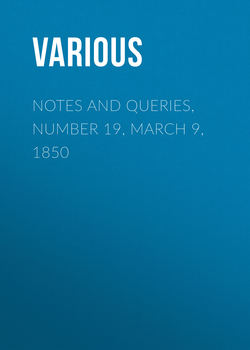Читать книгу Notes and Queries, Number 19, March 9, 1850 - Various - Страница 4
NOTES
WHAT IS THE MEANING OF "LÆRIG?"
ОглавлениеThis query, evidently addressed to our Anglo-Saxon scholars by the distinguished philologist to whom we are all so much indebted, not having been hitherto replied to, perhaps the journal of "NOTES AND QUERIES" is the most fitting vehicle for this suggestive note:—
TO DR. JACOB GRIMM.
Allow me, though an entire stranger to you, to thank you for the pleasure I have derived, in common with all ethnological students, from your very valuable labours, and especially from the Geschichte der Deutschen Sprache. At the same time I venture, with much diffidence, to offer a reply to your question which occur in that work at p. 663.:—"Was heisst lærig?"
Lye says, "Hæc vox occurrit apid Cædm. At interpretatio ejus minime liquet." In the Supplement to his Dictionary it is explained "docilis, tyro!" Mr. Thorpe, in his Analecta A.-S. (1st edit. Gloss), says, "The meaning of this word is uncertain: it occurs again in Cædmon;" and in his translation of Cædmon he thus renders the passage:—"Ofer linde lærig=over the linden shields." Here then lærig, evidently an adjective, is rendered by the substantive shields; and linde, evidently a substantive, is rendered by the adjective linden. In two other passages, Mr. Thorpe more correctly translates lindum=bucklers.
Lind, which Lye explained by the Latin labarium, vexillum, that excellent scholar, the late lamented Mr. Price, was the first, I believe, to show frequently signified a shield; which was, probably for lightness, made of the wood of the lime tree, and covered with skin, or leather of various colours. Thus we have "sealwe linde" and "hwite linde" in Cædm., "geolwe linde" in Beowulf.
All this is superfluous to you, sir, I know—"Retournons à nos moutons," as Maistre Pierre Pathelin says.
The sense required in the passage in Brythnoth seems to me to be:—
"bærst bordes lærig=the empty (hollow concave) shields
"and seo byrne sang=and the armour (lorica) resounded."
And in Cædmon:—
"ofer linde lærig=over the empty (hollow concave) shield."
In Judith, Th. Anal. 137, 53. we have a similar epithet:—
"hwealfum lindum=vaulted (arched concave) shields."
We should remember that Somner has ge-lær, void, empty, vacuus; and Lye, with a reference to the Herbarium, lær-nesse, vacuitas. In the Teuthonista we have lær, vacuus, concavus. In Heiland, 3, 4. "larea stodun thar stenuatu sehsi=empty stood there stone-vats six." I need not call to your mind the O.H.G. lári.
I think, therefore, we cannot doubt that what is intended to be expressed by the A.-S. lærig is empty, hollow, concave. But if we wanted further confirmation, leer, leery, leary are still in use in Devonshire, Dorsetshire, and perhaps elsewhere, for empty, hollow, as the provincial Glossaries will show. Skinner has the word leer, vacuus, and says, "foeliciter alludit Gr. [Greek: lagaros], laxus, vacuus." In Layamon we have (244, 16.), "the put wæs i-lær." I have found but one instance in Middle English, and that is in the curious old Phrase-Book compiled by William Horman, Head Master of Eton School in the reign of Henry VIII:—
"'At a soden shyfte leere barellis, tyed together, with boardis above, make passage over a streme.' Tumultuario opere, inanes cuppæ colligatæ et tabulatis instratæ fluminis transitu perhibent."—Hormanni Vulgaria, Lond. 1519, f. 272 b.
Instances of the word are not frequent, possibly because we had another word for empty (toom) in common with the Danes; but perhaps there was no necessity for dwelling upon it in the sense of empty; it was only its application as an epithet to a concave or hollow shield that your question could have had in view.
Once more thanking you most heartily for the pleasure and profit I have derived from the Deutsche Grammatik, and all your other important labours, I am, sir, your grateful and obliged servant,
S.W. SINGER.
Mickleham, Nov. 23. 1849.
